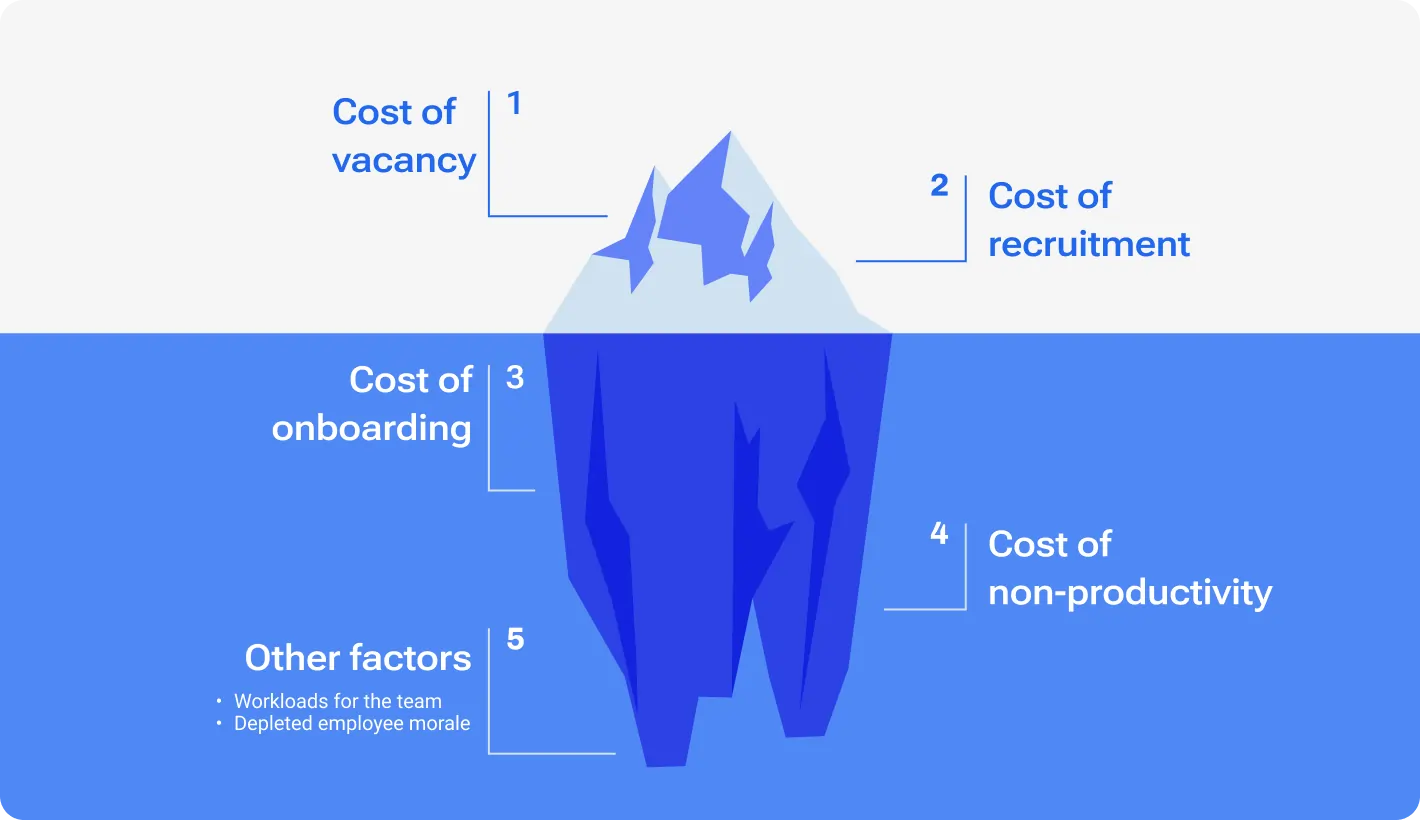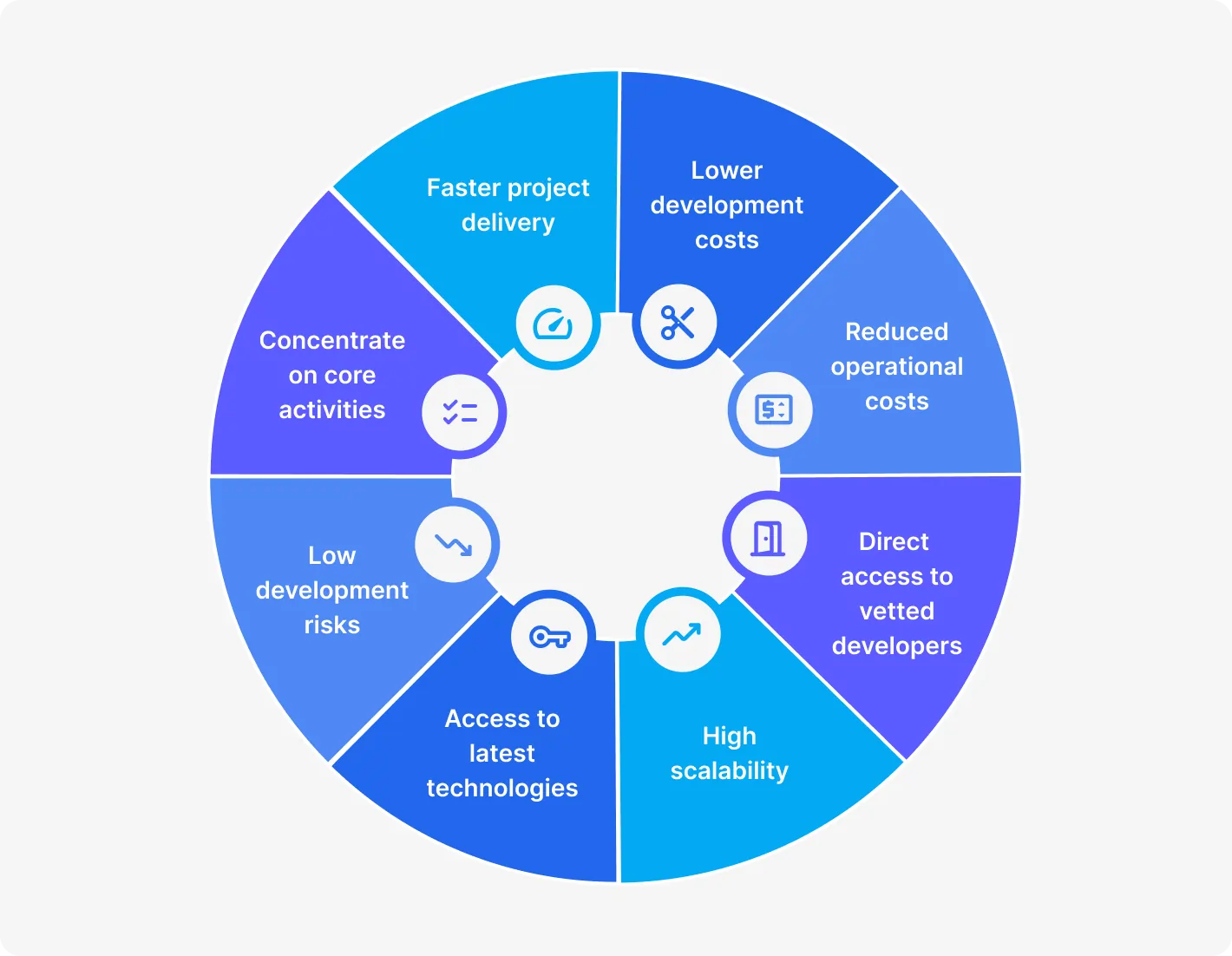A recent study by Gartner suggests turnover rates in many IT companies are reaching 29%. For tech firms, this is a disaster. Such a level of workforce change disrupts workflows, which increases costs as a result. In turn, research by Indeed finds that turnover can cost up to 33% of an employee’s annual salary.
The figures above uncover a pressing challenge tech firms now face. High employee turnover is now a reality in the whole tech industry, and businesses that want to stay afloat need to know how to deal with the problem at hand.
Luckily, software development outsourcing and staff augmentation services might be the answers everyone is looking for. The key hypothesis is that hiring offshore talent helps maintain continuity, cuts recruitment costs, and builds resilience during transitions.
In this article, we focus on giving practice advice, something that can help companies in the tech industry maintain workforce continuity. During the journey, we touch on strategies linked to dedicated teams and related topics. So, stay tuned.
The reality of employee turnover in tech
It would be reasonable to say that employee turnover is a fact of life in tech. That is why many companies rely on different staff augmentation strategies, including outsourcing, nearshoring, and offshoring. Tech firms do what they can to stay competitive and ensure turnover does not have that much of an impact on their ongoing projects.
Naturally, the proper response to the rising turnover is looking for outside experts to fill the workforce gaps. In such a case, a good starting point is to have a more in-depth understanding of turnover. Let’s start from the basics.
Differences between voluntary and involuntary turnover
Voluntary turnover occurs when employees choose to leave. They might resign for a better opportunity or personal reasons. In contrast, involuntary turnover happens when companies let employees go due to performance issues or restructuring.
Each type has its challenges. Voluntary turnover can suddenly leave projects without experienced team members. Involuntary turnover may force companies to fill roles quickly, sometimes using dedicated offshore developers. Both scenarios affect team dynamics and project continuity.
Companies that rely on freelance offshore talent sometimes experience smoother transitions. These professionals can step in quickly, which helps during high turnover periods. Meanwhile, firms may also use freelance offshore developers to cover short-term gaps.
Recognizing voluntary and involuntary turnover challenges is the first step in reducing disruptions.
The 8 hidden costs of turnover
Employee turnover is not a zero-cost thing. It often means more than just losing valuable team members. Turnover is a financial as well as operational burden.
While these are the fundamental “hidden costs,” there are some more factors to mention:
-
Financial burden. Turnover means you need to spend more on recruitment and onboarding. Besides, it accounts for lost productivity. The price of replacing key employees quickly adds up.
-
Operational costs. When your talent leaves, projects will likely suffer from a disruption. In many cases, it means missed deadlines. While delayed milestones are common with turnover, these further increase strain.
-
Impact on morale. High turnover has a definite impact on employee morale. People seeing their coworkers leave brings stress and burnout. In such a case, the remaining staff will be unlikely to deliver the best results.
-
Knowledge loss. Senior employees hold valuable insights as well as know-how about past projects. Often, when the technical documentation is no longer there, long-term employees are the ones who can give all the required answers. When you lose such workers, you get an expertise and knowledge gap.
-
Management overhead. For managers, turnover means spending extra time on onboarding, training, and task management. The additional workload diverts their attention from core project management activities and strategic initiatives.
-
Impact on clients. Frequent staff changes can have an adverse impact on client trust and consistency expected from you as a company. Disruptions in service and a perceived lack of stability can lead to lost business opportunities and damaged reputation.
-
Innovation disruption. Stable teams often build momentum in creative problem-solving and continuous improvement. Constant changes in team composition can interrupt collaboration processes, affecting the ability to steadily generate fresh ideas and effective solutions.
-
Communication issues and team cohesion problems. High turnover is a communication breaker. It also weakens team bonds. Rebuilding both communication and cohesion can take a great deal of effort and time.
As to the cost-related numbers:
For many positions, estimates suggest that replacing an employee can cost 50% to 200% of that employee’s annual salary. For example, G&A Partners report that the average cost to replace a terminated employee is roughly 50% of their yearly salary.
Jobvite research indicates that the cost can range from one-half to two times the employee’s annual salary, considering expenses such as recruiting, onboarding, and training.
Another perspective comes from an issue brief by Equitable Growth, which estimates that, on average, turnover costs are around 40% of an employee’s annual salary; however, this figure can vary greatly by industry and job level.
When costs rise, companies often turn to staff augmentation to stabilize operations. Many businesses use software development outsourcing to fill gaps quickly. These measures help reduce the impact of turnover on the bottom line.
Employee turnover in tech affects every aspect of a business. Understanding the visible and hidden costs prepares companies to seek effective solutions.
Key benefits of offshore developers in high-turnover scenarios
During the stressful high turnover time, offshore developers can serve as a remedy. Don’t think about that as a quick fix. Having a good software development outsourcing partner on your side is a strategic and long-term advantage.
High turnover often disrupts internal teams. Hiring offshore developers helps companies quickly fill talent gaps and access specialized skills. This method keeps projects on track during staffing changes. It also helps control costs.
1. Continuity. Keeping projects on track
Offshore teams help maintain consistent progress. They can take over work during transitions without missing a beat. Their experience in working remotely means they quickly adapt to new projects. This continuity minimizes the disruptions that typically come with turnover.
For example, companies that hire offshore developers often report that projects stay on schedule. This happens because offshore teams follow established workflows and maintain detailed documentation. Such practices help smooth handovers and keep teams aligned.
2. Scalability. Filling talent gaps on demand
Scalability is the synonym for dedicated offshore development team. When hiring offshore developers, companies can quickly scale their teams up and down. Such a degree of flexibility is particularly beneficial when your teams cannot meet project needs because of turnover-related talent gaps.
Often, businesses choose to use the power of dedicated teams. It brings faster resource allocation. How? A business can easily add new team members when a project expands or when a company loses a long-term team player. All of this comes without lengthy and costly recruitment cycles. For a volatile talent market, such an on-demand strategy is a must.
Scalability brought by software development outsourcing is a matching response to market changes. Offshore developers help bridge gaps by providing resources as needed.
3. Specialized skills. Accessing global talent
Access to a global talent pool means companies with experts from all corners of the globe with unique skillsets, both technical and soft. Using offshore software developers lets companies tap into niche expertise without geographic limits.
When a company needs a specific skill set, it might occasionally hire freelance developers or freelance software developers. This short-term approach helps fill roles with individuals with the required experience.
4. Cost optimization. Avoiding high local hiring costs
Cost control is a significant benefit brought by offshore developers. Hiring local talent can be expensive. To illustrate, while you can hire a Junior Software Engineer for $55-$80 per hour in the U.S., a professional with the same skill set will charge $25-$30 per hour in Eastern Europe. Such a drastic cost difference makes hiring freelance developers attractive. Offshore talent often comes at a lower rate, reducing overall expenses.
For example, when a company needs to expand its development team, it might hire freelance offshore developers or use Employer of Record (EOR) services. This approach cuts recruitment costs and avoids high local salary packages. Over time, the savings add up and help keep the budget in check.
5. Speed. Quick onboarding and immediate contribution
In tech projects, time is critical. Offshore developers often require less time to get up to speed. Their past work experience on global projects lets them contribute immediately. This quick start is crucial, especially when internal teams are disrupted.
6. Flexibility. Adapting to ever-changing project needs
Every project manager knows –projects do evolve. Requirements change, delivery pace shifts, and as a result real outcomes differ from expected. Offshore developers offer the advantage of adjusting to those evolving project needs. When a tech company can quickly hire the right talent to match shifting project needs, it means adaptation.
Overall, the quick onboarding of offshore teams minimizes disruption during turnover. This speed, cost, and scalability benefits make offshore developers a strategic asset for tech companies.
How to deal with a tech talent shortage?
Challenges in using offshore developers
Getting offshore developers on board won’t fix all your problems. While there are many definite benefits involved with dedicated developing team services, we cannot omit some challenges that are also there.
Let’s have a closer look at the obstacles involved.
Challenge #1. Knowledge transfer and documentation
Proper documentation is critical when working with offshore teams. A detailed knowledge transfer plan ensures that all project details are passed on accurately. Inadequate documentation can lead to significant delays. Some industry surveys report that poor knowledge transfer can increase project turnaround times by 20–25%.
Proper knowledge transfer and documentation tips:
1. Put in place a centralized knowledge repository with standardized documentation practices.
2. Schedule regular training for in-house and offshore teams to keep everyone up to date.
Challenge #2. Communication barriers and cultural variations
Access to global talent means you may work with people from all over the globe. While it is a major benefit because it brings people with different skill sets together, there is also a potential challenge involved. People from different countries often speak different languages and hold various cultural preferences. If not handled correctly, this can lead to misunderstandings within teams.
Besides, working with outsourcing teams can introduce communication challenges due to different time zones, languages, and work cultures. While studies suggest virtual communication can boost team productivity by up to 15%, if a team does not have well-established communication channels, productivity will decline rather than uptick.
Workable communication tips and tricks:
1. Adopt collaborative tools such as Slack or Microsoft Teams.
2. Establish overlapping work hours for live communication.
3. Conduct regular cross-cultural training sessions.
4. Use time zones to your advantage.
How does the offshore time difference work in your favor?
Challenge #3. Business goals misalignment
Outsourcing teams must clearly understand the company’s core objectives to deliver projects that meet business needs. Without clear direction, there is a risk that offshore efforts may diverge from strategic priorities. According to a survey by Moldstud, organizations with well-aligned teams have seen on-time project delivery rates improve by up to 25%.
Practical tips and strategies for business goal alignment:
1. Integrate offshore teams into strategic planning sessions.
2. Schedule regular alignment meetings.
3. Define clear, measurable objectives and key performance indicators (KPIs).
Challenge #4. Security and compliance risks
Security is a top concern when working with outsourcing developers. Companies must safeguard intellectual property and ensure data protection while meeting various compliance requirements. Forbes reported that firms implementing strict security measures experienced up to 30% fewer data breaches than those with lax protocols.
Useful pointers for security and compliance:
1. Adopt industry-standard security protocols.
2. Set up encrypted communication channels, multi-factor authentication, and regular security audits.
3. Provide comprehensive compliance and security training for offshore teams.
Addressing security and compliance risks goes a long way. Even if taking care of this challenge might require additional investment, don’t hesitate to do so. Data breaches and non-compliance are too costly in terms of reputation and fines. As Forbes puts it, “Fines alone can cost hundreds of millions of dollars.”
Overall, when it comes to hiring outsourced developers, keep in mind knowledge transfer, communication barriers, goal misalignment, and compliance risks. If you deal with these potential issues in advance, software development outsourcing will be a breeze and not a headache.
Time-proven strategies to keep projects on track during the turnover phase
The success of any project stems from planning and backup. In other words, if you account for all the variables and have backup systems in place, not much can catch you off-guard.
When turnover disrupts teams, having a solid strategy is essential. Companies can use practical frameworks to assess skills, compare costs, and evaluate timelines.
Strategy 1. Build a turnover-proof development process
A turnover-proof process starts with smooth workflows. Companies should set up clear guidelines and standard procedures. These practices help in maintaining consistency, even when key staff members leave.
Developing a strong workflow includes the use of tested project management tools, such as:
Regular code reviews, paired programming, and continuous integration keep quality high. This approach works well when hiring offshore developers as part of a broader strategy. Always keep in mind this mantra — a well-designed development process minimizes disruptions during turnover.
Strategy 2. Create a redundancy plan with offshore talent
Redundancy planning means having backup resources ready for when turnover occurs. Companies should maintain a pool of software outsourcing vendors that can be called upon at any time.
It means you can replace lost expertise quickly. A redundancy plan is a proactive measure that prepares companies for unexpected staff changes.
Bonus strategies
Along with the two fundamental strategies above, some “less” important practices still might be suitable for your particular project or case. The more options you have, the more likely you are to find the best one that fits your needs.
-
Implement cross-training programs. Train multiple team members on critical tasks to prevent single points of failure. This approach ensures that knowledge is shared and that project progress isn’t stalled when someone leaves.
-
Build a redundancy talent pool. Maintain a reserve of pre-vetted offshore or freelance developers who can be called upon quickly when turnover occurs. This proactive measure reduces downtime and maintains momentum.
-
Monitor performance metrics and provide regular feedback. Establish key performance indicators (KPIs) for project progress and team productivity. Regular monitoring and feedback allow managers to identify bottlenecks early and adjust resource allocation.
-
Establish flexible resource allocation plans. Develop contingency plans that allow for rapid reassignment of tasks across offshore and onshore teams when staff changes occur. Flexibility ensures that critical tasks are always covered.
Putting all the puzzle pieces together, one thing is clear — nothing new under the sun. Many companies have successfully overcome the high turnover phases. You don’t need to repeat their path of trial and error. The strategies above are tested with time.
Choosing the right offshore partner
One of the key aspects of success with staff augmentation and software development outsourcing is the offshore partner on your side. A tech company can use many factors to maximize the chance of getting a good partner on board. These often correlate to expertise, security, scalability, communication, and alignment with business or project goals.
When it comes to doing the work, namely evaluating offshore partners, track records and client testimonials are crucial in staff augmentation. You check if the prospective partner had an experience of delivering a similar project, the one matching your particular needs. In the best-case scenario, you need to look for a partner that can build a solid dedicated team and grant you access to pre-vetted offshore software developers as quickly as possible. To find such a partner, consider various criteria.
Criteria for evaluating offshore partners
There is no one-size-fits-all with offshore partners. You need to evaluate each particular candidate against a set of criteria. As a good starting point, evaluate the following aspects:
1. Expertise/experience
A reliable offshore partner will always have a proven track record to showcase their portfolio. In the tech industry, having case studies is a must. Keep in mind that expertise should include both large-scale projects and agile teams. In other words, an offshore partner should show they can handle both large and small projects.
There are various websites you can use to check company reviews. Besides, each offshore partner should have case studies posted on their website.
2. Scalability
The partner must be able to provide additional resources quickly. A scalable solution is important when you need to fill gaps due to turnover. Partners offering Employer of record (EOR) services often provide flexible solutions that grow with your business.
Scalability equals flexibility. When an offshore partner can quickly scale up or down your team, there is a higher chance for a company to deal with the market changes and high turnover. Yet, you need to discuss room for scalability in advance to understand whether a prospective partner can handle flexibility.
3. Security
Poor security and non-compliance cost a lot, we established that previously. So, you need to be particularly cautious and careful with this evaluation criterion. To the best of your ability, evaluate the security measures an offshore partner uses. If unsure, delegate this task to a security or compliance professional. They can check the partner’s certification, licensing, and security measures.
Potential offshore partners must follow industry standards and offer secure communication channels. This aspect is critical to safeguard your intellectual property and sensitive data.
4. Communication/cultural fit
The offshore partner must understand your business culture. Regular communication and clear goals help create a smooth working relationship. Consider partners who have worked with dedicated offshore developers and freelance offshore teams, as this experience can translate into better integration with your operations.
5. Cost-effectiveness
Compare the cost structure of different partners. While price is important, value and quality should drive your decision. For instance, knowing how much freelance web developers charge can help benchmark expenses and make informed choices.
Choosing the right offshore partner is vital to achieving long-term success. Clear evaluation criteria help companies build partnerships that promote growth and stability. With a reliable partner, managing turnover becomes easier without compromising on quality.
Wrapping up
High turnover in tech can:
Offshore developers offer a proven solution to maintain continuity and keep projects on track. They provide:
These aspects help reduce the impact of staff changes.
Choosing a partner with expertise, scalability, and security practices is key. Companies hiring offshore developers can benefit from a stable, cost-effective solution for managing turnover. They can also work with a dedicated team to secure project continuity and smooth transitions.
If you want to boost your competitive edge with an experienced staff augmentation vendor, contact Devico today.
End-to-end solutions with predictable budgets, a time-to-market advantage with budget savings of up to 50%





